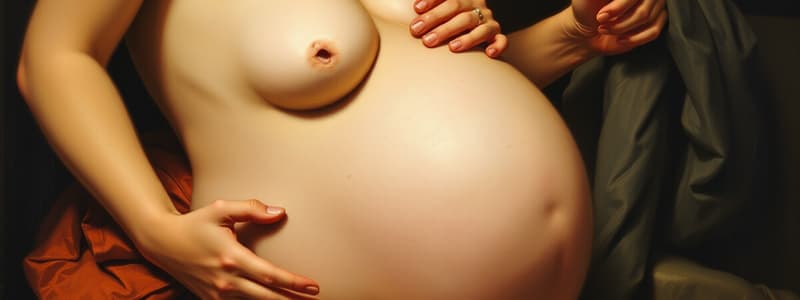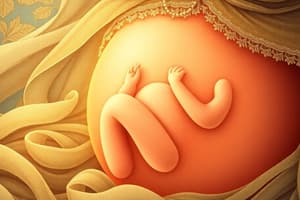Podcast
Questions and Answers
What does fetal presentation refer to?
What does fetal presentation refer to?
- The ratio of fetal size to the uterus
- The part of the fetal body that is foremost in the birth canal (correct)
- The pregnant woman's posture during labor
- The position of the mother during delivery
Which of the following best describes fetal attitude?
Which of the following best describes fetal attitude?
- The fetal heart rate during labor
- The type of contractions the uterus undergoes during labor
- The typical posture the fetus assumes in the womb (correct)
- The relationship between the fetal long axis and the mother's axis
Which of the following factors affects the powers responsible for labor progression?
Which of the following factors affects the powers responsible for labor progression?
- Pelvic size and shape
- Fetal presentation abnormalities
- Maternal anxiety and pain tolerance
- Uterine contraction patterns (correct)
What does the term 'passage' refer to in the context of dystocia?
What does the term 'passage' refer to in the context of dystocia?
Which statement best describes the role of 'psyche' in labor?
Which statement best describes the role of 'psyche' in labor?
What is the primary goal of internal rotation during face presentation?
What is the primary goal of internal rotation during face presentation?
What is commonly used to estimate fetal head size?
What is commonly used to estimate fetal head size?
During labor with a face presentation, which mechanism helps facilitate delivery?
During labor with a face presentation, which mechanism helps facilitate delivery?
What results from the relation of the fetal body to the deflected head during birth?
What results from the relation of the fetal body to the deflected head during birth?
In face presentation, which fetal position ensures that the occiput is in contact with the fetal back?
In face presentation, which fetal position ensures that the occiput is in contact with the fetal back?
Which factor is seldom a suitable explanation for failed labor in cases of dystocia?
Which factor is seldom a suitable explanation for failed labor in cases of dystocia?
What characterizes brow presentation during labor?
What characterizes brow presentation during labor?
What is a common outcome of a persistent brow presentation?
What is a common outcome of a persistent brow presentation?
In which presentation does the fetal head and shoulder lie perpendicular to the mother's pelvis?
In which presentation does the fetal head and shoulder lie perpendicular to the mother's pelvis?
What is the often seen fetal position during a sinciput presentation?
What is the often seen fetal position during a sinciput presentation?
What may occur in the absence of complications during transverse lie?
What may occur in the absence of complications during transverse lie?
Which incision is typically indicated for cesarean delivery in cases of transverse lie?
Which incision is typically indicated for cesarean delivery in cases of transverse lie?
What occurs in a compound presentation?
What occurs in a compound presentation?
What should be done if the prolapsed arm in a compound presentation does not retract?
What should be done if the prolapsed arm in a compound presentation does not retract?
Which of the following describes a potential outcome if the arm does not retract during a compound presentation?
Which of the following describes a potential outcome if the arm does not retract during a compound presentation?
What condition can occur due to excessive pressure on soft tissues in the birth canal during dystocia?
What condition can occur due to excessive pressure on soft tissues in the birth canal during dystocia?
Which of the following complications is characterized by severe pain and may require immediate transfer to the operating room?
Which of the following complications is characterized by severe pain and may require immediate transfer to the operating room?
What is a common cause of postpartum lower extremity nerve injury during childbirth?
What is a common cause of postpartum lower extremity nerve injury during childbirth?
Which complication is related to the mechanical trauma of the fetus during delivery?
Which complication is related to the mechanical trauma of the fetus during delivery?
What can be a result of direct compression of the fetal head against the pelvic floor during labor?
What can be a result of direct compression of the fetal head against the pelvic floor during labor?
What type of fistula may develop days after delivery due to impaired circulation from excessive pressure?
What type of fistula may develop days after delivery due to impaired circulation from excessive pressure?
Flashcards are hidden until you start studying
Study Notes
Fetal Presentation and Positioning
- Fetal Lie: The alignment of the fetal long axis in relation to the mother's long axis; can be longitudinal or transverse.
- Fetal Presentation: The part of the fetus that is closest to the birth canal, categorized as cephalic (head first), breech (buttocks or feet first), or shoulder presentation.
- Fetal Attitude: The posture of the fetus, typically folding into an ovoid shape that matches the uterine cavity; influenced by fetal growth and space constraints within the uterus.
Dystocia and Its Contributing Factors
- Dystocia: A condition of challenging labor characterized by slow progression; assessed through the four P's: Powers, Passenger, Passage, and Psyche.
Powers
- Refers to uterine contractions; analyzes if contractions are normal, regular, and effective in facilitating dilation and descent.
Passenger
- Focuses on fetal abnormalities related to presentation, position, or anatomical issues, such as tumors (e.g., neck tumors) or congenital conditions (e.g., anencephaly).
Passage
- Involves anatomy of the birth canal, including bony pelvic contractions or soft tissue abnormalities that can impede descent, such as cephalopelvic disproportion (CPD) or soft tissue obstructions (e.g., vaginal tumors, Bartholin's cysts).
Psyche
- Emphasizes the mother's mental state during labor, including anxiety and pain tolerance; involves strategies like breathing exercises and providing reassurance to improve comfort and progress.
Dystocia Due to Passenger
- Fetal size alone is rarely the sole cause of failed labor; most disproportion cases occur in fetuses of average weight.
- Disproportion in labor may depend more on fetal positioning than on size.
Fetal Head Size Estimation
- Mueller-Hillis Maneuver:
- Employs abdominal application of pressure to grasp the fetal brow and suboccipital region.
- Pressure is directed downward along the axis of the inlet for assessment.
Cephalic Malpresentations
- Types include face, brow, and sinciput presentations.
Face Presentation
- Occurs when the head is hyperextended, positioning the occiput against the fetal back and presenting the chin (mentum).
Mechanism of Labor: Face Presentation
-
Descent: Influenced by:
- Amniotic fluid pressure.
- Fundal pressure during contractions.
- Maternal abdominal muscle efforts.
-
Internal Rotation:
- Aim is to reposition the chin under the symphysis pubis.
-
Flexion:
- Required to navigate through the birth canal effectively.
-
Extension:
- Converts the fetal body's position into a two-armed lever.
- The longer arm extends from the occipital condyles to the occiput, enabling chin descent while overcoming resistance at the occiput.
-
External Rotation:
- Occurs subsequently as the fetal positioning adjustments continue.
Brow Presentation
- Rare fetal positioning with the head segment between the orbital ridge and anterior fontanel at the pelvic inlet.
- Diagnosis occurs when the specific head portion presents during delivery.
- Labor tends to be easier with smaller fetuses but can be challenging with larger ones.
- Often a transient presentation, typically converts to vertex or face presentation.
- Persistent brow presentation poses a poor prognosis for vaginal delivery.
Sinciput Presentation
- Also known as military position; characterized by an erect fetal posture.
- Generally transient, with the frontal part of the skull leading into the birth canal.
- Occurs when the fetal neck is partially flexed, causing the large anterior fontanel to present.
Transverse Lie Presentation
- Fetal orientation is perpendicular to the mother's long axis, creating a shoulder presentation.
- The shoulder rests over the pelvic inlet, with the head in one iliac fossa and the breech in the other.
- Pregnancy is classified as right or left acromial based on the shoulder positioning.
- Management typically indicates cesarean delivery due to potential complications.
- External version attempts may be advised before or early in labor with intact membranes.
- A low transverse incision may complicate fetal extraction; vertical or classic incisions are often preferred.
Compound Presentation
- Characterized by an extremity (typically an arm) prolapsing alongside the presenting part (usually the head) into the pelvis.
- Occurs simultaneously in the birth canal, which can complicate delivery.
Causes
- Results from conditions that hinder complete occlusion of the pelvic inlet by the fetal head.
- Includes factors such as preterm labor which may lead to an improper positioning of the fetus.
Management
- Close observation is critical when an arm is prolapsed with the head to monitor retraction.
- If the prolapsed arm does not retract as the presenting part descends, intervention is necessary.
- Gentle upward pressure should be applied to the prolapsed arm while simultaneously applying fundal pressure to encourage downward movement of the fetal head.
Prognosis
- Depends on the ability of the arm to retract and the effectiveness of management strategies during labor.
- Quick and appropriate responses can improve outcomes during delivery.
Complications with Dystocia: Maternal
-
Uterine Rupture
- Occurs when there is significant disproportion preventing fetal engagement or descent.
- The lower uterine segment becomes overstretched, leading to rupture.
- Symptoms include severe pain; emergency transfer to the operating room (OR) is often required.
- Pathological retraction ring of Bandl may be observed.
-
Fistula Formation
- Prolonged pressure on the soft tissues of the birth canal can lead to tissue necrosis.
- Excessive pressure can compromise circulation, resulting in the formation of fistulas like vesicovaginal, vesicocervical, or rectovaginal.
- Fistulas may manifest several days post-delivery.
-
Pelvic Floor Injury
- Childbirth may cause direct compression to the pelvic floor from the fetal head.
- Mother's expulsive efforts exert additional downward pressure, potentially leading to injuries.
-
Postpartum Lower Extremity Nerve Injury
- Most commonly caused by external compression of the common fibular nerve.
- Often results from improper leg positioning in stirrups, particularly during prolonged second stage labor.
- This injury can lead to temporary or permanent deficits in lower limb function.
-
Perinatal Complications
- Caput succedaneum: Swelling or edema of the fetal scalp occurring during delivery.
- Molding: Abnormal shaping of the fetal head due to pressure during labor.
- Mechanical trauma can result in nerve injuries, fractures, and cephalhematoma, further complicating delivery outcomes.
Studying That Suits You
Use AI to generate personalized quizzes and flashcards to suit your learning preferences.




